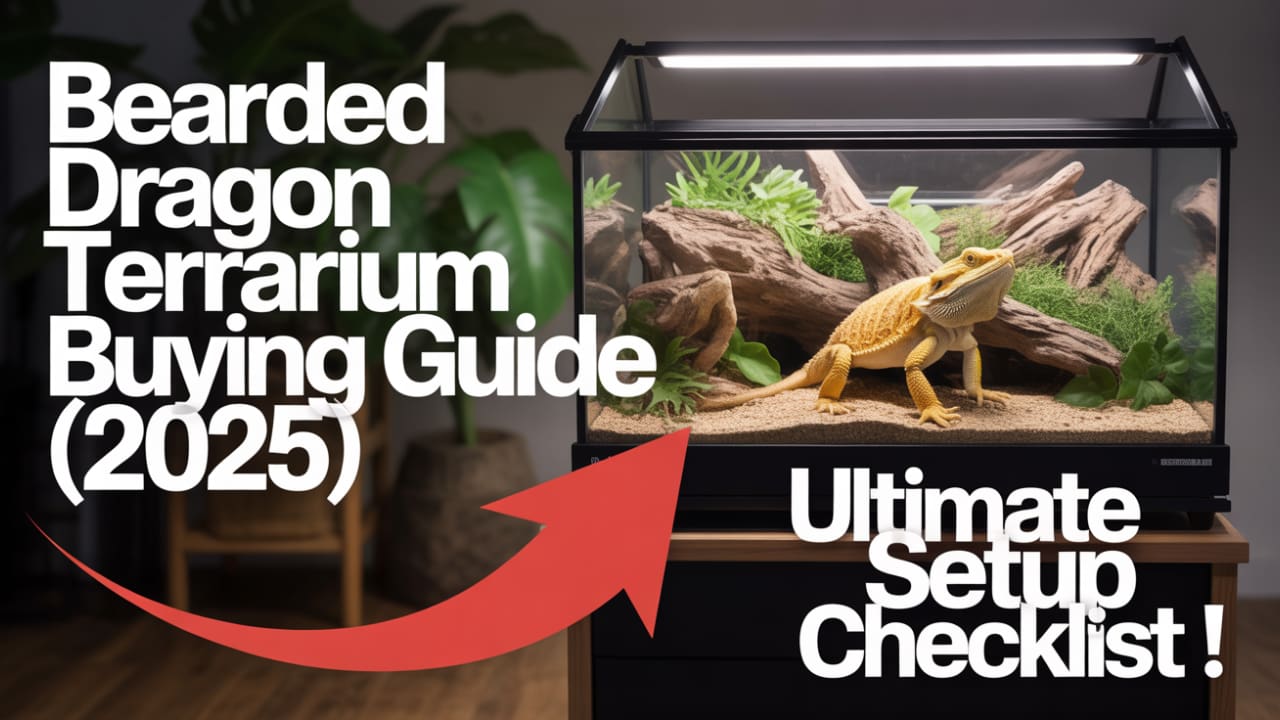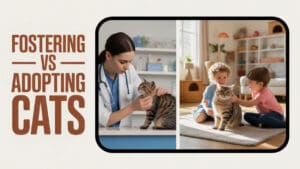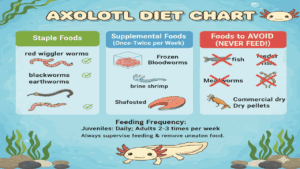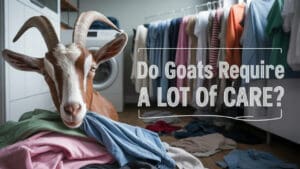Bearded Dragon Terrarium Buying Guide (2025): Expert Tips on Size, Materials, Setup, Decor & Costly Mistakes to Avoid
We know. Setting up your first bearded dragon terrarium can feel quite overwhelming. And this is especially the case when every decision, from tank size to lighting, could affect your pet’s health.
You want to get it right the first time. But between flashy kits and DIY builds, it’s hard to know what actually works. So here’s what counts.
Most beginners underestimate how quickly a dragon outgrows a 55-gallon tank. They overspend on poor-quality lighting that leads to health problems, or unknowingly use unsafe decor that may risk impaction or injury.
What should you do instead?
For starters, adult dragons need a terrarium that’s at least 120 gallons. And that’s not even a luxury. It’s a minimum.
Kits can be convenient, but many come with subpar coil UVB bulbs that don’t meet reptile care standards. And while decor might seem like a fun add-on, unsafe substrates like sand or sharp hides can cause more harm than good.
So, the smartest choices often involve upfront investment, trusted materials like PVC or sealed wood, and a heating setup that includes a ceramic emitter for nighttime warmth.
If you’re serious about getting a terrarium that supports long-term health (not just short-term convenience), this guide is your shortcut to doing it right.
How big of a terrarium does a bearded dragon need?
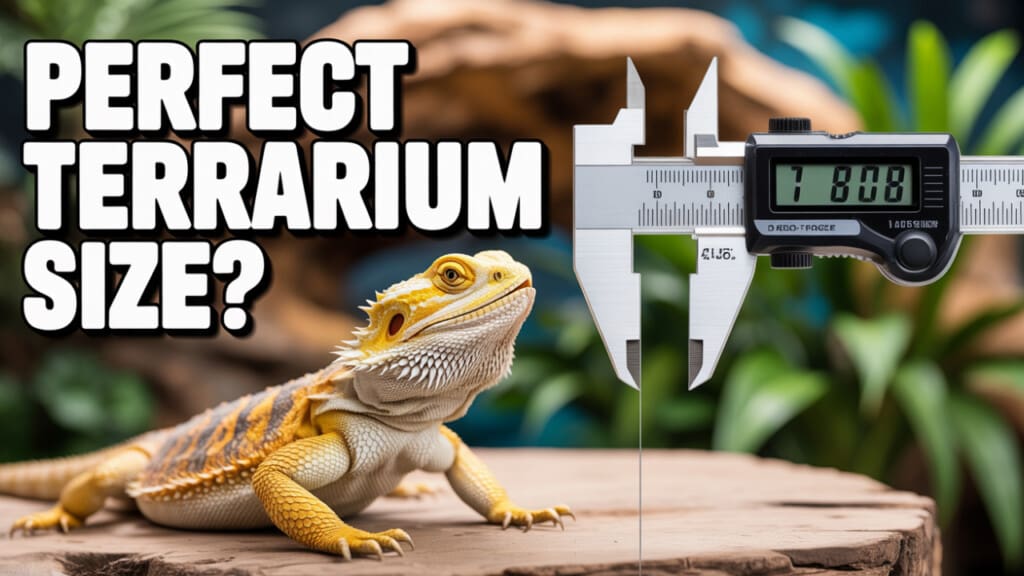
Naturally, you’d want to give your bearded dragon the home it deserves. And size absolutely matters.
These reptiles may start out small, but they grow fast. And a cramped enclosure can lead to chronic stress, stunted growth, and health issues.
So how big of a terrarium does a bearded dragon need? The answer depends on age, but even hatchlings benefit from space to explore, bask, and thrive.
Let’s break it down. For baby bearded dragons (under 10 inches long), a 20-gallon terrarium might seem adequate for the first couple of months. But it becomes obsolete quickly.
Juveniles (10–16 inches) need at least 55-75 gallons, while adults (17–24+ inches) require a minimum of 120 gallons.
Long enclosures (at least 4 feet in length) are more important than tall ones. Beardies are, after all, ground dwellers that need horizontal space for exercise and thermoregulation.
We notice that a lot of first-time owners purchase an enclosure that’s too small, thinking they can upgrade later. But upgrading means added costs, wasted materials, and unnecessary stress on the animal.
Exotic reptile specialists note that it’s more cost-effective and humane to start with an adult-size terrarium, even for young dragons. Plus, larger terrariums allow for better temperature gradients. And these are essential for digestion and immune function.
Cost-wise, you should expect to spend about $200–$500 on a properly sized glass or PVC terrarium. Of course, this depends on build quality and features too.
Some bearded dragon terrarium kits include the correct size and essentials. But you should always verify internal dimensions. Some manufacturers do inflate volume by adding unnecessary height.
So, you want your bearded dragon to live its healthiest, happiest life? Start with space. Because a well-sized terrarium isn’t just a box. It’s a foundation for long-term reptile care.
Choosing the right terrarium build: Glass, wood, or PVC?
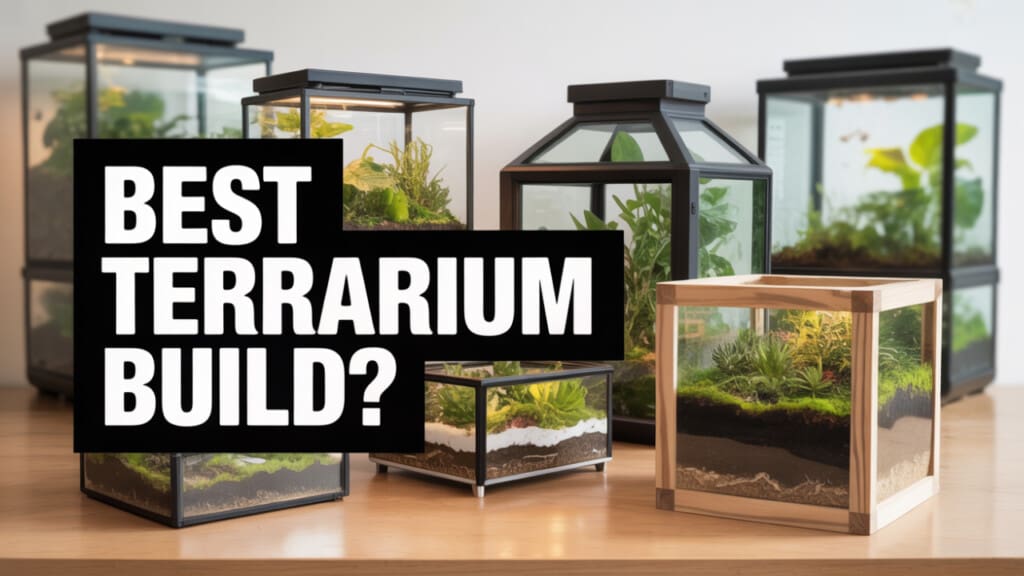
If you’re shopping for a bearded dragon terrarium, one of the first big decisions you’ll face is what material to choose. And this (in all seriousness) is not just about looks.
The build of your terrarium directly impacts your dragon’s comfort, your maintenance effort, and your long-term costs. So what’s the real difference between glass, wood, and PVC enclosures?
Let’s start with glass terrariums, the most widely available option and often included in starter kits.
Glass offers excellent visibility and is ideal for showcasing your pet. However, it can be harder to maintain consistent heat, especially in cooler climates. Why? Because glass doesn’t insulate well.
Many new owners make the mistake of using glass without proper insulation. This usually leads to temperature regulation issues that stress out their beardies.
Now, wooden terrariums. Typically made from melamine or plywood. They are popular among DIY enthusiasts and provide superior insulation, making them energy-efficient and ideal for maintaining heat and humidity.
But here’s the catch: Wood is vulnerable to moisture and must be sealed properly to prevent warping, rot, or mold. Experts say that wooden builds are best for experienced keepers who can monitor conditions closely.
Then there’s PVC enclosures, a rising favorite for serious reptile owners. Lightweight yet sturdy, PVC holds heat well, resists moisture, and is easy to clean.
While they can cost more upfront (typically $300–$700 depending on size and brand), they often outlast glass and wood in both durability and performance. This makes PVC a smart investment if you’re aiming for a low-maintenance, long-term habitat.
You might be wondering which is right for you now. If you’re just starting out, a high-quality bearded dragon terrarium kit with a glass build may suffice.
But long-term, PVC or sealed wood enclosures offer the best balance of comfort, efficiency, and reliability. Choose based on your climate, budget, and how hands-on you want to be.
Quick Comparison: Glass vs. PVC vs. Wood Enclosures
| Material | Heat Retention | Durability | Cost Range | Humidity Range | Best For | Cleaning | Ventilation |
| Glass | Poor (needs strong bulbs) | Fragile (can crack/chip) | $150–400 | 0–50% | Beginners, display | Easy, streaks | Good with mesh top |
| PVC | Excellent (20% better) | Very durable, lightweight | $250–600 | 0–100% | All climates, pros | Wipes clean | Customizable vents |
| Wood/Melamine | Very good (insulates) | Durable, can rot if wet | $200–500 | 0–50% | Cold/dry climates | Can absorb odors | Limited options |
Summary:
- Glass: Great visibility, easy to find, but loses heat quickly
- PVC: Retains heat, lightweight, lasts years, best for serious keepers
- Wood: Good for DIY, but avoid moisture and always seal inside
Heating, lighting, and UVB: What your terrarium setup must include
What’s the single most important part of your bearded dragon terrarium setup after size? Heating and lighting—especially UVB—are non-negotiable if you want your dragon to stay healthy and thrive.
Your cold-blooded reptile friends rely entirely on external heat and light sources to regulate their metabolism, digest food, and even absorb essential nutrients.
Let’s break it down. Your terrarium should include two types of lighting: a basking heat lamp to simulate the sun, and a UVB light to help your dragon synthesize vitamin D3, which is crucial for calcium absorption.
Without proper UVB exposure, bearded dragons are at high risk for metabolic bone disease. This is a painful, often irreversible condition (so do take this seriously).
Experts recommend using a 10.0 UVB bulb that spans at least two-thirds of the enclosure’s length. But remember, coil UVB bulbs don’t cover enough area and often lead to underexposure. This is a common (and costly) beginner mistake.
Your setup should also include a temperature gradient. One side of the tank should be a basking zone (around 95–110°F depending on age), while the other remains cooler (75–85°F). At night, turn off visible light sources and use a ceramic heat emitter if temperatures drop too low.
Now, all these components come at a price. You can expect to spend $80–$150 on quality heating and UVB gear. But, investing in a bearded dragon terrarium setup that includes high-grade fixtures can save you from vet bills down the line.
It’s also smart to install digital thermometers and timers to maintain consistency. Your dragon might thank you for it later.
In short, lighting isn’t just about visibility. It’s about survival. Prioritize quality, mimic nature, and don’t cut corners when it comes to UVB. Your bearded dragon’s long-term wellness starts with the right glow.
Bearded dragon terrarium decor and accessories to avoid health risks
Decorating your bearded dragon’s terrarium is more than just a matter of style. It’s a health-critical decision. The wrong accessories can cause stress, injury, or even (God forbid) life-threatening conditions.
It may be tempting to load the enclosure with plants, rocks, and colorful decor. But not all accessories are beardie-safe. So, what’s worth including? And what should you absolutely avoid?
Loose substrate is often labeled a decor-related danger. But the real issue isn’t the substrate itself. It’s poor husbandry.
While materials like calcium sand or ground walnut shells may contribute to impaction under the wrong conditions, natural options like sand or bioactive mixes are generally safe when reptiles are properly hydrated, heated, and exposed to UVB.
Accidental ingestion can occur during feeding. But healthy reptiles usually pass small amounts without issue. Instead of avoiding loose substrates entirely, focus on maintaining correct environmental conditions to minimize risk.
Then, we have the climbing branches and basking rocks. While these enrich your pet’s habitat, anything with sharp edges or unstable bases poses a serious injury risk.
You should try to opt for smooth, sturdy pieces that can’t be easily shifted or toppled. And try to avoid using outdoor wood or rocks unless they’ve been properly sanitized and baked to kill parasites or fungi.
Decor with artificial plants or plastic vines? Use sparingly. If your bearded dragon starts to nibble on them, they can become a choking hazard.
But if you’re looking to go the extra mile, handcrafted DIY hides made from food-safe materials are both enriching and cost-effective. Just make sure they’re easy to clean and well-ventilated.
So, you want to upgrade your bearded dragon terrarium decor without compromising safety? Stick to reptile-tested accessories that support natural behavior, offer basking opportunities, and keep hygiene in check.
Always prioritize health over aesthetics. Because when it comes to your dragon’s habitat, safe is stylish.
Should you buy a bearded dragon terrarium kit or build your own?
So, you’re preparing to welcome a bearded dragon into your home? One of the first big questions might look like this.
Should you buy a ready-made terrarium kit or customize your own setup from scratch? It’s not just a matter of preference. It’s a strategic decision that affects your pet’s well-being and your wallet.
Bearded dragon terrarium kits are designed to simplify the process for beginners. These bundles typically include a tank, heating lamp, UVB bulb, thermometer, and sometimes even starter decor. For someone new to reptile care, these kits offer convenience and peace of mind.
But be careful. Remember that not all kits are created equal.
Many may come with inadequate lighting, subpar substrates, or undersized enclosures that are only suitable for hatchlings. If you’re not cautious, you may find yourself replacing half the kit within weeks.
Now, building your own bearded dragon terrarium setup gives you full control over quality, size, and materials. You want to install a high-output UVB strip or custom basking ledge? DIY setups allow for that level of precision.
While the initial cost may be higher (ranging from $300 to $700, depending on materials and equipment), you’re investing in long-term health and fewer upgrades down the road. Most exotic pet specialists also agree that a well-planned custom build often provides better heat retention, lighting, and safety.
Still, many owners start with a bearded dragon terrarium kit and gradually upgrade components. This hybrid approach can work well if you research the kit thoroughly and identify where you may need to supplement or swap parts.
Let’s take a step back and think about this carefully. If you’re short on time or brand new to reptile care, a vetted kit offers a low-barrier entry point.
But if you’re serious about creating an optimized, long-lasting habitat, building your own terrarium is (objectively) the smarter path in the long run.
Bearded dragon terrarium ideas to inspire your habitat design
We know, and we know. Designing a bearded dragon terrarium isn’t just about function. It’s an opportunity to create a miniature desert ecosystem that’s both beautiful and enriching.
The best terrarium designs do more than look good. They stimulate your dragon’s natural behaviors and make maintenance easier.
So if you’re looking for bearded dragon terrarium ideas to inspire your habitat design, you’re in the right place.
Let’s start with the basics. A well-designed setup always includes elevation and depth.
Try stacking basking rocks or driftwood in one corner to form a climbing area, while leaving open floor space for roaming. Many owners opt for desert-themed decor with faux sandstone hides, cactus replicas, and a gradient of warm-toned substrates.
And if you want a cleaner, modern look? Some go minimalist with sleek PVC backdrops, reptile-safe tiles, and modular LED accents that mimic daylight cycles.
Here’s where creativity comes to life. You can create DIY hides and caves using sealed terracotta pots, cork bark, or stacked slate, giving your dragon places to cool off or nap. Just make sure everything is stable. One wrong shift could result in injury.
Experts recommend spot-gluing decor to tile bases to prevent shifting, especially in active dragons. And if you’re on a budget, using foam backgrounds coated with non-toxic sealants can add dimension without the weight or cost of stone.
What does this mean for your wallet? Decor-focused terrarium builds typically cost $50–$150 more than barebones setups, depending on materials. But that extra investment goes a long way in reducing boredom and boosting quality of life.
A thoughtfully designed environment doesn’t just please the eye. It keeps your dragon mentally stimulated and physically active.
One more tip. Always prioritize safe, non-toxic decor that supports climbing, hiding, and basking. With the right inspiration, your bearded dragon’s habitat can be a work of art and a thriving ecosystem rolled into one.
Common buying mistakes new owners make with terrarium setups
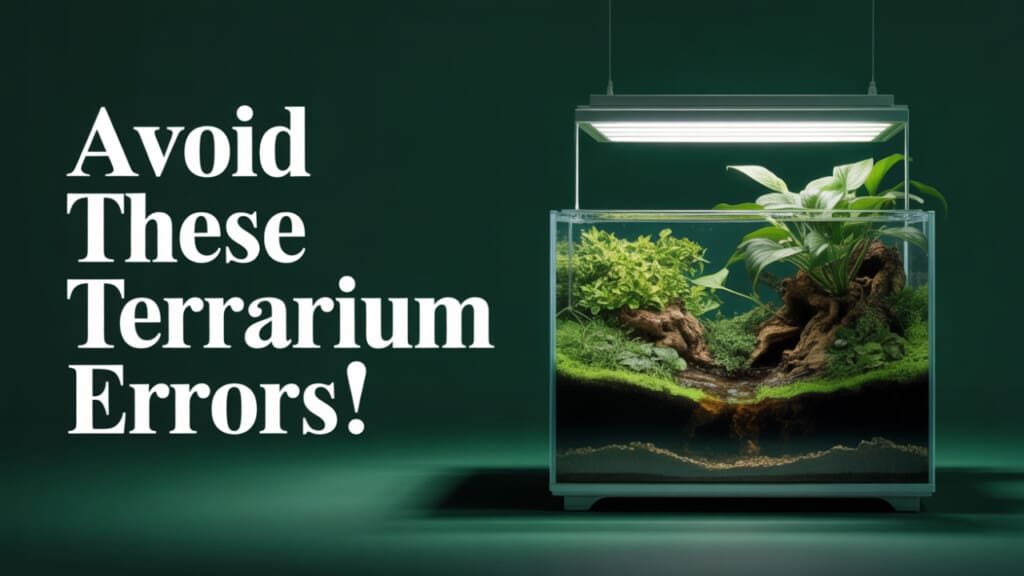
Yes, you’re excited. Setting up a terrarium for your bearded dragon is indeed exciting. But it’s also where many first-time owners stumble.
The truth is, even well-meaning decisions can lead to costly errors and long-term health issues for your pet. If you’re planning your first setup, knowing what to avoid is just as important as knowing what to buy.
One of the most frequent mistakes? Choosing a tank that’s too small. New owners often purchase a 20- or 40-gallon terrarium because it seems sufficient for a young dragon.
But bearded dragons grow quickly, and cramped quarters can lead to stunted growth, aggression, and stress. Always start with a 120-gallon minimum to accommodate an adult, even if you’re raising a baby.
Another common oversight is buying low-quality lighting and heating equipment. Cheap heat bulbs and coil-style UVB lights may save money upfront but fail to provide the consistent heat and full-spectrum lighting that dragons require.
Most reptile vets agree that poor lighting setups are likely the top cause of metabolic bone disease. What does this mean for you?
Invest in reputable brands and complete bearded dragon terrarium kits that meet lighting and heat specifications. Chances are, you’ll avoid bigger vet bills later.
Substrate choice is another minefield. Many pet store kits include loose sand, which can cause fatal gut impaction if ingested. Instead, you should opt for solid, easy-to-clean surfaces like reptile carpet, ceramic tile, or non-adhesive shelf liner.
Lastly, don’t overload your terrarium with decorations. We understand that it’s tempting to create a vibrant mini-desert. But too much clutter can restrict movement and airflow. Always leave space for natural behaviors like basking and exploring.
The bottom line? Smart terrarium setup starts with planning, not impulse buying. Avoiding the common traps ensures a safer, healthier habitat, and definitely a much happier dragon.
2025 Product Recommendations Table
| Category | Product Name | Price Range | Why Recommended | Where to Buy | Avoid Instead |
| Best PVC Enclosure | Zen Habitats 4x2x2 | $299–369 | Superior heat retention, 5yr warranty | ZenHabitats.com | Generic glass tanks |
| Best Budget Glass | REPTIZOO 120gal | $220–300 | Full adult size, sturdy, good value | Amazon, Chewy | PetSmart 40gal kits |
| Premium UVB Kit | Arcadia ProT5 12% UVB Kit | $80–120 | Professional grade, 12% output, replace every 6mo | Reptile specialty stores | Compact UVB bulbs |
| Night Heating | Fluker’s Ceramic Heat Emitter | $25–45 | No light, thermostat compatible | Amazon, pet stores | Red/blue night lights |
| Temp Monitoring | Etekcity Infrared Temp Gun | $15–30 | Instant, accurate surface readings | Amazon | Dial thermometers |
| Bioactive Kit | The Bio Dude Terra Sahara Kit | $100–200 | Self-cleaning, natural behavior | TheBioDude.com | Calcium sand substrate |
Frequently Asked Questions About Bearded Dragon Terrariums
Still perplexed in starting your journey with a bearded dragon? You’re not alone in having a dozen questions about terrarium size, heating, lighting, and everything in between.
Making informed decisions early can save you time, money, and stress, and ensure your reptile thrives from day one. Below are the most frequently asked questions about bearded dragon terrariums, curated to address the real concerns of new and prospective owners.
1. Is it okay to leave a heat lamp on overnight?
No, visible heat lamps should be turned off at night to simulate a natural day/night cycle. If your room gets colder than 65°F, use a ceramic heat emitter to keep your bearded dragon warm without disrupting sleep.
2. How do I know if my bearded dragon is too cold at night?
If your dragon appears lethargic, isn’t eating, or feels cool to the touch in the morning, your nighttime temperature may be too low. Place a digital thermometer near the basking and cool zones to monitor both ends accurately.
3. Do bearded dragons prefer tall or long tanks?
Bearded dragons need long, horizontal tanks, not tall ones. They’re ground-dwelling reptiles that rely on lateral movement for exercise and proper thermoregulation. A tank that’s 4 feet long is ideal for adults.
4. What is the best environment for a bearded dragon?
They thrive in dry, desert-like enclosures with a temperature gradient, basking spots, and UVB lighting. The right bearded dragon terrarium setup should mimic their natural habitat, helping regulate body functions and behavior.
5. What not to put in a bearded dragon tank?
Avoid loose substrates (like sand or crushed walnut), sharp decor, heat rocks, and overcrowding. These can cause impaction, burns, or stress. Stick to safe decor and solid flooring like tile or reptile carpet.
6. What size terrarium should I get for an adult bearded dragon?
At a minimum, 120 gallons is required for an adult, though a larger tank always offers better comfort. Buying the right size from the start avoids costly upgrades and prevents health issues.
7. Are bearded dragon terrarium kits worth it for first-time owners?
They can be! Kits simplify setup, especially if they include proper lighting and heating. Still, many contain low-quality components. So always verify each item’s specs before purchase.
8. Should I get a glass, PVC, or wood terrarium?
Glass is affordable and easy to find. PVC offers better insulation and durability, while wooden enclosures work well when sealed and ventilated. Choose based on climate, budget, and maintenance preferences.
9. Can I build my own bearded dragon terrarium?
Absolutely! DIY builds are common among experienced reptile owners. Just make sure you use safe, sealed materials and provide proper ventilation, heating, and UVB coverage. Mistakes here can affect your dragon’s health.
10. Where is the best place to buy a bearded dragon terrarium online?
Trusted sources include Chewy, Amazon, PetSmart, and specialty reptile supply stores. Look for customer reviews, return policies, and accurate size descriptions before you click “Buy.”
Still deciding? Just keep this in mind. A great terrarium isn’t about fancy decor. It’s about creating a safe, comfortable, and functional space that supports your dragon’s lifelong health.
What’s the smartest way to choose your bearded dragon terrarium?
It comes down to making informed decisions before you buy, not after.
Now you know that an adult dragon needs at least a 120-gallon enclosure, that coil UVB bulbs are a mistake, and that loose substrate can lead to serious health risks. You’ve also seen how PVC enclosures outperform glass in heat retention, and why starter kits are only as good as their components.
Okay, you’re no longer shopping blind. You’re ready to pick a habitat that supports long-term comfort, health, and safety for your bearded dragon.
Take the next step with confidence. Explore trusted terrarium kits, compare heating options, or start sketching out your dream DIY build. Your dragon deserves more than the basics. And now, you’re equipped to deliver it.
What’s one thing that worked (or didn’t work) in your bearded dragon terrarium? Share your experience. Let us know in the comments down below.

